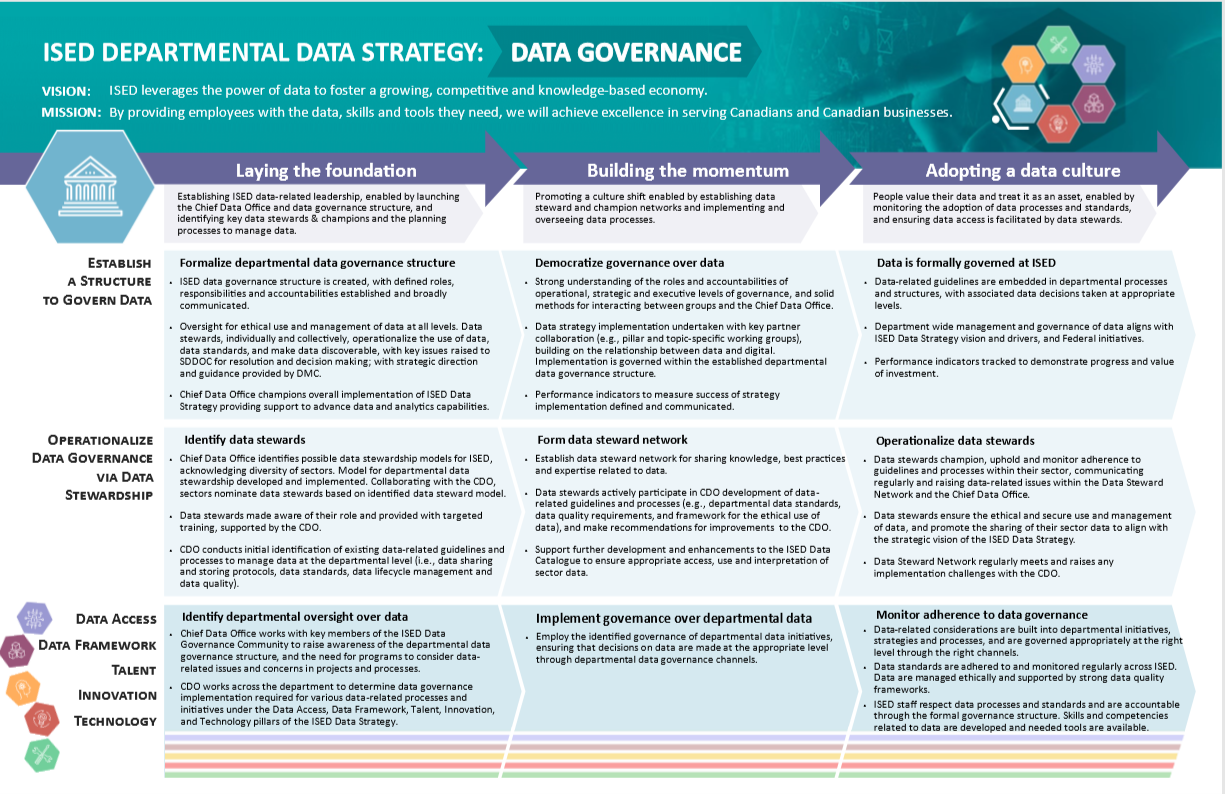Important: The GCConnex decommission will not affect GCCollab or GCWiki. Thank you and happy collaborating!
Data Governance Pillar
(Français: Pilier de la gouvernance des données) (Home Page: ISED Data Strategy)
What is the Data Governance Pillar?
The Data Governance Pillar is one of the 6 pillars of the ISED Data Strategy. Strong data governance is foundational to developing an ISED data culture that treats data as a strategic asset. Data governance means having data-related leadership, with clearly defined roles, responsibilities and accountabilities with decision-making authority within a structure to govern data. Data standards for quality and metadata, as well as data management processes throughout the data lifecycle are also critical components of data governance.
Data Governance Initiatives
Strong data governance is fundamental for any organization that works with data, as it ensures clear data-related roles and responsibilities as well as consistent and common processes for working with data. This includes establishing data standards and defining the processes to manage data. Data stewardship is making sure the standards are applied, and decisions around data are made and monitored at all levels. ISED’s Digital, Data and Services Oversight Committee (DDSOC) has been established to transform how we operate, make decisions and deliver services by leveraging our data assets and harnessing the power of digital technologies. Of particular interest to the CDO is the committee’s mandate to transform the management and use of the department’s data assets by formalizing governance mechanisms and processes for data. This includes committee members from across ISED championing the implementation of ISED’s Data Strategy, enabling data sharing to derive greater insight from data while addressing matters of privacy, security and ethics. For more information please see the Data Governance Placemat.
Formalize a departmental data governance structure with clear roles and responsibilities for all involved:
To make data decisions, we need the right data players at the right level. This means establishing a structure with defined roles, responsibilities and accountabilities to guide data-related decision making with a process to develop, review and approve foundational activities to ensure ISED-wide adoption of data-related guidelines, processes and standards.
- Formalize a Departmental Data Governance Structure
Identify and establish a departmental Data Steward Model that aligns with sector requirements and activities, and examples of typical activities of a data steward:
We are working with sectors to identify the data stewardship model that is appropriate for them to ensure data decisions are made at the right level and shared across all sectors. Sharing knowledge, best practices and expertise related to data, such as data standards and quality, appropriate access, secure data sharing, and data analytics will grow the department’s knowledge base and amplify our ability to derive insight from data
- Departmental Data Steward Model
- Data Steward Roles
- Typical Activities of a Data Steward
- ISED Data Stewards
Identify processes to manage and govern data at the enterprise level (data sharing, standards, quality, etc.):
With a solid understanding of the roles, responsibilities and accountabilities for data decisions at all levels, we will build a culture where all treat data as an asset, and are able to derive greater value from data. Building on existing processes to govern data across the department, we are looking to harmonize and standardize how we govern data to ensure consistency and interoperability of data assets.

